Temporomandibular
disorders
- Temporomandibular
disorders
- What is the temporomandibular joint?
The temporomandibular joint is one of the smaller joints of the human body, but is also one of the most complex. It connects the mandible to the skull base; it is double and it has a complex movement of rotation and translation, which allows us to open and close our mouth.
Inside the temporomandibular joint, there is a fibrocartilage disc, which is similar to the meniscus of the knee, which divides the joint itself into an upper compartment and a lower compartment. The articular disc is interposed between the bone of the jaw (condyle) and the bone of the skull base (temporal fossa). It is a dynamic structure as it moves with the condyle of the mandible during its movement.
The joint is covered on the inside, partly by a membrane called the synovium that produces the synovial fluid (inside the joint) and partly by cartilage.
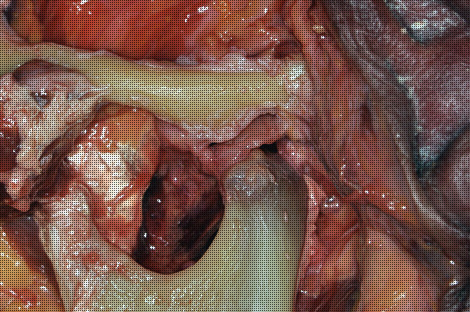
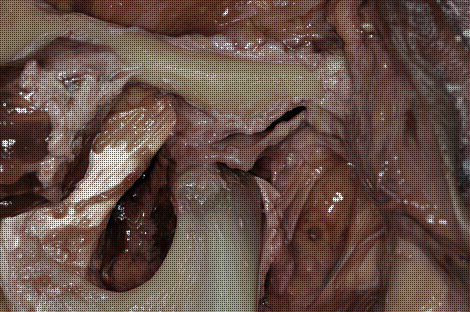
Anatomical preparation showing the normal temporomandibular joint when the mouth is closed and open
The temporomandibular joint is part of the masticatory system (or cranio-mandibular system). The masticatory system is composed of the teeth of the upper and lower arches (which together make up the dental occlusion), the masticatory muscles and temporomandibular joint. It is controlled by a number of centers at the level of the central nervous system and the main functions are mastication, speech and swallowing.
What are temporomandibular disorders (TMD)?
The temporomandibular disorders (TMD) are pathological conditions characterized by pain and dysfunction in the masticatory system that can affect the muscles and/or temporomandibular joint and the structures connected to them.

If the disease is limited to the masticatory muscles there is a myofascial temporomandibular disorder, if the temporomandibular joint is involved, the disease is called temporomandibular joint disorder or Internal Derangement (ID). Very often the temporomandibular disorders affect both the muscles and the joints.
The temporomandibular disorders are the most common cause, after dental pain, of the orofacial pain.
Studies on the general adult population have shown that this condition is widespread and increasing: 10-15 percent of the population has a pain due to a temporomandibular disorder, and about 5 percent needs medical treatment. Women are much more affected than men (8-9 times more) and the highest prevalence occurs in the third/fifth decade of life.
Only in the U.S., it is estimated that about 35 million people are suffering from this disease.
What are the causes of temporomandibular disorders?
The etiology is multifactorial; usually it's not just one but many factors that determine the onset of the disease. Among the main causes of temporomandibular disorders are traumas: fractures and bruises in the joints and muscles, forced or prolonged openings (dental sessions or intubation for surgeries), whiplash from car accidents, parafunctional habits (bruxism and clenching).
Other causes may be some systemic diseases such as autoimmune diseases (rheumatoid arthritis, fibromyalgia, etc.). Also genetic, hormonal and metabolic disorders could play a role in the etiopathogenesis. A special mention deserves the malocclusion because for years they have been accused of causing temporomandibular disorders in a "occlusocentric" conception. Currently it can be said with certainty and on the basis of the data available in scientific literature, that all the malocclusions cannot be responsible and determine temporomandibular joint disorder but only some of them may be due to a predisposing factor. A possible cause is a change in the occlusion that may be due, for example, to inadequate dental care, displacement or loss of teeth, incongruous dentures, etc.
Another factor that plays a critical role in determining temporomandibular disorders is the psyche/stress.
How do temporomandibular disorders develop and what are the symptoms?
If one of the parts of this system does not function properly, the other components of the system may be affected.
The classic example is represented by people who respond to stress at the work place or in their private life (divorce, bereavement, etc.), by grinding their teeth. This is commonly known as bruxism (if it happens at night) or clenching (if it happens during the day). This happens because the brain tells the muscles of mastication to continuously bite. This not only ruins the patient’s teeth, but causes fatigue and pain in the masticatory muscles themselves, which are stressed by the constant chewing. However, also the temporomandibular joint, which is part of the system, is overloaded and undergoes stress and its interior can be damaged and joint pain can occur.
Other symptoms of temporomandibular disorder are as follows: movement restrictions (lock jaw), noise at the level of the temporomandibular joint (click ), headache, neck pain, and ear problems such as tinnitus. If not diagnosed and treated properly and promptly, it may be accompanied by other disorders, such as chronic pain, anxiety and depression, which affect the quality of life of patients.
What happens to the temporomandibular joints affected?
In temporomandibular joint disorders, pain at the preauricular level (patients often refer to as the ear) and movement restrictions are due to a change in the position of the articular disc and an inflammation.
In healthy temporomandibular joints, the articular disc is positioned as a cap over the mandibular condyle and follows its movement during the opening stages of the jaw (rotation and translation).
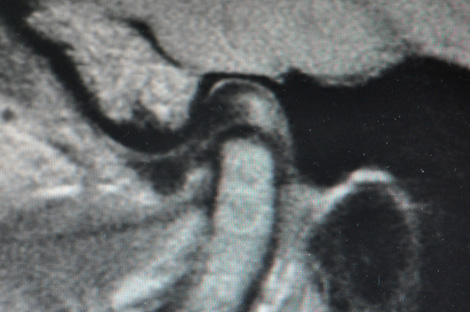
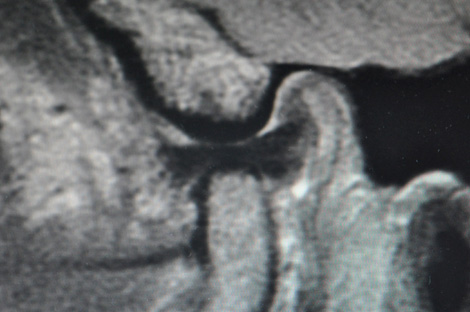
Magnetic Resonance Imaging of the normal temporomandibular joint when the mouth is closed and open mouth showing the disc in the correct position, above the mandibular condyle
If the disc moves anterior-medially, this condition is called disc displacement. Initially the displacement of the disc is with reduction in the sense that, when opening the mouth, the condyle moves, the disc slides back and gets back in the correct position above the condyle, producing an audible noise in the joint called the articular click. Suddenly the disc does not come back and the jaw no longer generates the click. This condition that determines a block of the jaw (closed lock) is characterized by a displacement of the disc without reduction, which occurs with pain and difficulty in opening the mouth. This closed lock may persist for a few seconds/minutes or hours or even be permanent and chronic.
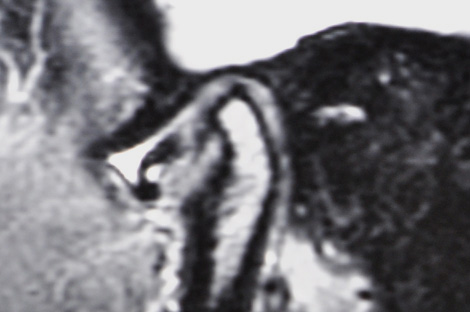
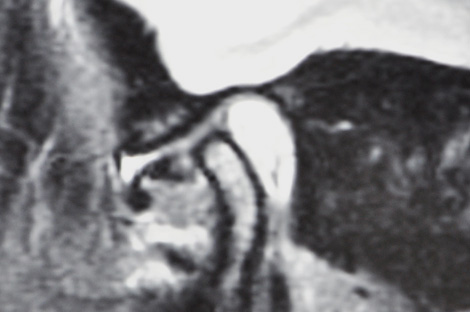
Magnetic Resonance Imaging of the temporomandibular joint when the mouth is closed and open showing a disc displacement without
reduction and articular effusion
In these cases, it is necessary to consult a specialist as soon as possible, to try to unlock the jaw and, therefore, not to make the disc displacement become chronic. In the closed lock that last for a long time, it is now impossible to unlock the jaw and retrieve the location of the disc; first there is an inflammatory condition of the joint (a joint effusion) and then there is the formation of intra-articular fibrous adhesions that lead to an extreme restriction of the joint mobility.
Another condition that can cause a joint lock is called "suction effect" of the disc (or fixed disc) that adheres strongly to the tissues and causes an impaired joint function.
In the later and severe phases, the evolution of the dysfunctional disease moves to the osteoarthritis of the temporomandibular joint, in which the tissues degenerate, the cartilage (chondromalacia) is destroyed, the disc is perforated, synovial polyps are formed, the bone joints are deformed; all this causes the typical joint pain and crackling or roar, which are characteristics of this condition.






